 |
Chinese
Manned Space Program: The Future |
 |
Chinese
Manned Space Program: The Future |
China
has a three-phase manned space plan that was defined in early days of the Project
921. The three phases are, to develop a manned transportation system and finally
put a man in space (by 2002 as originally planned), to establish a man-tender
8-ton class mini space station (the Space Laboratory, by 2007 as originally
planned), and to complete a permanent manned space station (after 2010 as
originally planned). Shenzhou 5 marks successful completion of the phase one.
 Just
days after the Shenzhou 5 flight, China announced that the Shenzhou 6 mission
would take place in 2005 with more taikonauts onboard and will fly more days. As
all previous unmanned and manned Shenzhou spacecraft keep a launch interval of
about one year, the two-year gap looks unusual. A possible reason is that
priority of the manned program has been lowered after the historic Shenzhou 5
flight that has fulfilled most of short-term objectives. It matches recent talks
by some space officials and scientists who implied a slower-as-expected post
Shenzhou 6 schedule. Nevertheless, the Shenzhou 6 spacecraft will be almost
identical to the Shenzhou 5. Latest reports indicate that it will carry two
taikonauts and will fly five days. The crew will take off spacesuit and will
enter the orbital module to conduct scientific experiments. They will also use
facilities inside the orbital module, for example toilet, for the first time.
The launch date is scheduled in September or October 2005. Similar to the
Shenzhou 5 mission, crewmembers will be decided days before the launch. Reports
indicate that manufacture and testing of the spacecraft and training of
taikonauts are very smooth. Assembly of modules started in early 2005. They will
be stacked in summer for final testing.
Just
days after the Shenzhou 5 flight, China announced that the Shenzhou 6 mission
would take place in 2005 with more taikonauts onboard and will fly more days. As
all previous unmanned and manned Shenzhou spacecraft keep a launch interval of
about one year, the two-year gap looks unusual. A possible reason is that
priority of the manned program has been lowered after the historic Shenzhou 5
flight that has fulfilled most of short-term objectives. It matches recent talks
by some space officials and scientists who implied a slower-as-expected post
Shenzhou 6 schedule. Nevertheless, the Shenzhou 6 spacecraft will be almost
identical to the Shenzhou 5. Latest reports indicate that it will carry two
taikonauts and will fly five days. The crew will take off spacesuit and will
enter the orbital module to conduct scientific experiments. They will also use
facilities inside the orbital module, for example toilet, for the first time.
The launch date is scheduled in September or October 2005. Similar to the
Shenzhou 5 mission, crewmembers will be decided days before the launch. Reports
indicate that manufacture and testing of the spacecraft and training of
taikonauts are very smooth. Assembly of modules started in early 2005. They will
be stacked in summer for final testing.
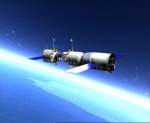
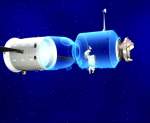 China
has denied EVA, rendezvous and docking activities on Shenzhou 6. But we are sure
that all of these are already in the plan, though without an official schedule.
There are reports saying that Chinese already developed the EVA spacesuit, most
likely a Russia design too, as the case of intra-vehicular Shenzhou spacesuit.
There are also reports on the docking system. An early 2004 report says that a
Shanghai based space institute has successfully developed the docking mechanism
and claims that China is only the second country to master such a technology. It
confirmed that China has selected the APAS-89 design, which is consistent with
an earlier revealed Space Laboratory photo (see below). China officials imply
that EVA will be performed as early as in the Shenzhou 7 mission, likely be
launched in 2007. Rendezvous and docking missions will be followed by. Also,
Chinese space officials have been talked about a unique docking test approach
that requires only one spacecraft to dock with an existing in-orbit orbital
module left by the previous mission. So, it is reasonable to expect Shenzhou 7,
as earliest, to carry a docking adapter on its orbital module and the first
docking test by Shenzhou 8 within 6 months, probably later 2007 or 2008.
China
has denied EVA, rendezvous and docking activities on Shenzhou 6. But we are sure
that all of these are already in the plan, though without an official schedule.
There are reports saying that Chinese already developed the EVA spacesuit, most
likely a Russia design too, as the case of intra-vehicular Shenzhou spacesuit.
There are also reports on the docking system. An early 2004 report says that a
Shanghai based space institute has successfully developed the docking mechanism
and claims that China is only the second country to master such a technology. It
confirmed that China has selected the APAS-89 design, which is consistent with
an earlier revealed Space Laboratory photo (see below). China officials imply
that EVA will be performed as early as in the Shenzhou 7 mission, likely be
launched in 2007. Rendezvous and docking missions will be followed by. Also,
Chinese space officials have been talked about a unique docking test approach
that requires only one spacecraft to dock with an existing in-orbit orbital
module left by the previous mission. So, it is reasonable to expect Shenzhou 7,
as earliest, to carry a docking adapter on its orbital module and the first
docking test by Shenzhou 8 within 6 months, probably later 2007 or 2008.
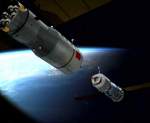
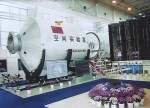
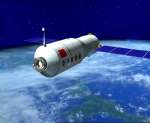 China
has unveiled computer animations and mockup photos of the planned Space
Laboratory, a man-tender mini space station, but without any details and
development status. The animation and the photo show that the spacecraft has two
sections, a small diameter cylinder with a pair of solar panels that seems to be
the propulsion/service segment based on the Shenzhou propulsion module, and a
large diameter cylinder likely an enlarged Shenzhou orbital module. The
laboratory has a single docking port on its top. Its size and mass are still
unknown but above disclosed information are consistent with the early plan to
launch an 8-ton class mini station by the CZ-2F rocket. Neither launch schedule
nor numbers of laboratories to be launched have been announced. It is believed
that the first launch will be before 2010 and very limited numbers of it will be
launched. It is only a transitional spacecraft to accumulate experiences for the
future space station.
China
has unveiled computer animations and mockup photos of the planned Space
Laboratory, a man-tender mini space station, but without any details and
development status. The animation and the photo show that the spacecraft has two
sections, a small diameter cylinder with a pair of solar panels that seems to be
the propulsion/service segment based on the Shenzhou propulsion module, and a
large diameter cylinder likely an enlarged Shenzhou orbital module. The
laboratory has a single docking port on its top. Its size and mass are still
unknown but above disclosed information are consistent with the early plan to
launch an 8-ton class mini station by the CZ-2F rocket. Neither launch schedule
nor numbers of laboratories to be launched have been announced. It is believed
that the first launch will be before 2010 and very limited numbers of it will be
launched. It is only a transitional spacecraft to accumulate experiences for the
future space station.
 A
permanently man occupied space station is the ultimate objective in the current
three-stage manned program. China has stated that it will be at 20-ton class,
will be launched by the newly developed heavy launcher (unofficially called CZ-5,
right picture), and will be modularly expandable. It is believed that the station is
still in very early design stage, but undoubtedly it will be designed and built
on experiences earned in Shenzhou and Space Laboratory programs, as well as
knowledge of Soviet/Russian Salyut and Mir stations. Reasonable timetable to
build and launch such a space station is next decade. There are too many
uncertainties on its way to space. Considering its huge cost and long
development cycle, it could be affected by economical or funding problems,
domestic politics changes, and possible international space cooperation etc.
A
permanently man occupied space station is the ultimate objective in the current
three-stage manned program. China has stated that it will be at 20-ton class,
will be launched by the newly developed heavy launcher (unofficially called CZ-5,
right picture), and will be modularly expandable. It is believed that the station is
still in very early design stage, but undoubtedly it will be designed and built
on experiences earned in Shenzhou and Space Laboratory programs, as well as
knowledge of Soviet/Russian Salyut and Mir stations. Reasonable timetable to
build and launch such a space station is next decade. There are too many
uncertainties on its way to space. Considering its huge cost and long
development cycle, it could be affected by economical or funding problems,
domestic politics changes, and possible international space cooperation etc.
In
earlier 2004, China announced the plan to recruit female taikonauts. According
to the plan, recruitment will be nationwide (including Hong Kong and Macao), and
candidates can be high school students, scientists or other professionals.
Female taikonauts will be payload specialists so that selection criteria will
not be as strict as previous selections. The selection is expected to start some
time 2005 and the training is to take about five years. Scientists also said
that it is necessary and needs time to modify current equipment (for example,
spacesuit) for female taikonauts. On the other side, the new selection, with
focus on payload specialists, is reasonably open to both male and female
candidates.
Technically,
Shenzhou spacecraft can be modified to perform lunar and deep space missions,
such as the Soviets did in later 1960s (7K-L1/Zond and 7K-LOK), or can be
striped down (by removing the orbital module) to perform low cost LEO missions.
However, the only derived version that Chinese space scientists have confirmed
is a cargo version. The cargo ship, currently under consideration, will be
similar to the Russian Progress but with more cargo capacity. It is believed
that the cargo Shenzhou is designed to support the future permanent space
station instead of the near-term Space Laboratory. As a result, its first launch
will not be before 2010. On the other side, in Soviet/Russian space history,
manned spacecraft can also be used as basis of unmanned spacecraft. For example,
there are various Vostok derived spacecraft such as Zenit, Resurs, Foton, Bion
etc. So far China has never revealed any similar plans.
 Although
winged spacecraft or shuttle lost to the current Shenzhou design earlier in the
Project 921 development, it is believed that studies are still ongoing. A
scientist said on media in earlier 2004 that China would eventually introduce a
reusable space transportation system by 2020. It is likely a two-stage-to-orbit
launch vehicle(right picture) instead of a manned craft. In further long term, China will focus
on air-breathing space transportation systems. There are indications, mostly
research papers, that China has advanced propulsion studies at academic level.
As for Shenzhou’s successor, it may be too early to say what it would be. It
is interesting to see how China’s next generation manned spacecraft will be
influenced by other new manned vehicles, specifically the Russian Kilper and the
U.S. CEV.
Although
winged spacecraft or shuttle lost to the current Shenzhou design earlier in the
Project 921 development, it is believed that studies are still ongoing. A
scientist said on media in earlier 2004 that China would eventually introduce a
reusable space transportation system by 2020. It is likely a two-stage-to-orbit
launch vehicle(right picture) instead of a manned craft. In further long term, China will focus
on air-breathing space transportation systems. There are indications, mostly
research papers, that China has advanced propulsion studies at academic level.
As for Shenzhou’s successor, it may be too early to say what it would be. It
is interesting to see how China’s next generation manned spacecraft will be
influenced by other new manned vehicles, specifically the Russian Kilper and the
U.S. CEV.
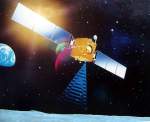 There
are always rumors that China has a plan to send human to the moon. Some even
predict that it would happen within a decade. That is not the fact, however.
Manned lunar exploration is neither a target of Project 921 nor part of any
other plans. Separately, China kicked off an unmanned lunar program in February
2004. It includes three stages. The first stage is to launch a lunar orbiter by
end of 2006. The orbiter, named Chang’e 1(right picture), is based on the DFH-3 bus and will
be launched by a CZ-3A. According to recent reports, the program is going
smoothly and development of the flight model has started. A 50m-diameter
receiver in Beijing and a 40m one in Kunming are under construction. They will
join existing 25m antennas in Shanghai and Urumqi to form a VLBI tracking
system. The second stage is to do a soft landing on lunar surface with a rover.
The lander development is still in very early stage. But many organizations have
showcased their rover prototypes. It has been decided that the rover design will
be selected through a nationwide competition. The third stage is a sample return
mission. There are no official schedule set for the second and the third stages.
Scientists suggest that they would be after 2010 and after 2015 respectively.
Manned lunar mission is only a vision for now, even thought the head of CNSA
(China National Space Administration) openly talked about the possibility
recently. Technically a modified Shenzhou and the heavy version of the new
generation launcher would make a Zond type circumlunar mission at earliest by
end of this decade, and a further enhanced heavy launcher with maximum LEO
capacity of about 70-ton would support an Soviet N1/L3-like lunar landing
mission some time next decade. Unfortunately, both are unlikely to happen. There
are already debates in China for its huge cost and less scientific values.
Realistically, manned lunar and deep space missions would become serious
programs decades later, and the final technical approach would be totally
different from what we discussed here.
There
are always rumors that China has a plan to send human to the moon. Some even
predict that it would happen within a decade. That is not the fact, however.
Manned lunar exploration is neither a target of Project 921 nor part of any
other plans. Separately, China kicked off an unmanned lunar program in February
2004. It includes three stages. The first stage is to launch a lunar orbiter by
end of 2006. The orbiter, named Chang’e 1(right picture), is based on the DFH-3 bus and will
be launched by a CZ-3A. According to recent reports, the program is going
smoothly and development of the flight model has started. A 50m-diameter
receiver in Beijing and a 40m one in Kunming are under construction. They will
join existing 25m antennas in Shanghai and Urumqi to form a VLBI tracking
system. The second stage is to do a soft landing on lunar surface with a rover.
The lander development is still in very early stage. But many organizations have
showcased their rover prototypes. It has been decided that the rover design will
be selected through a nationwide competition. The third stage is a sample return
mission. There are no official schedule set for the second and the third stages.
Scientists suggest that they would be after 2010 and after 2015 respectively.
Manned lunar mission is only a vision for now, even thought the head of CNSA
(China National Space Administration) openly talked about the possibility
recently. Technically a modified Shenzhou and the heavy version of the new
generation launcher would make a Zond type circumlunar mission at earliest by
end of this decade, and a further enhanced heavy launcher with maximum LEO
capacity of about 70-ton would support an Soviet N1/L3-like lunar landing
mission some time next decade. Unfortunately, both are unlikely to happen. There
are already debates in China for its huge cost and less scientific values.
Realistically, manned lunar and deep space missions would become serious
programs decades later, and the final technical approach would be totally
different from what we discussed here.
China
expressed its willing to participate the ISS program many times in recent years.
It never got positive feedback from the United States, the leading partner of
the ISS. The fact is that Sino-US space cooperation has been totally interrupted
since mid-1990s when cooperation on commercial space launch was alleged with
illegal technology export to China. It is foreseeable that there will be no
joint space programs between China and the United States unless there are major
policy changes at the US side. In contrast, cooperation with Russia and Europe
could become an interesting development. ESA and China has successfully launched
two DoubleStar satellites. China has officially participated the Galileo
project, and are discussing further cooperation with Europe. China and Russia
have signed a series of agreements on space cooperation since early 1990s. The
two countries did have technological exchanges during China’s Shenzhou
development. Technically, a Shenzhou visit to ISS could be realized within this
decade after China perfected their rendezvous and docking technologies (please
note the ISS compatible APAS-89 docking adapter). There are also rumors that
there would be a Sino-Russia joint research module on ISS. However, all these
could be easily proven very unlikely if considering US’s opposition. But how
about a Sino-Russia or a Sino-Europe joint mission similar to the 1970s ASTP
program? Technically it is much easier and politically it is more feasible. We
will not be surprised if a Shenzhou-Soyuz or a Shenzhou-ATV joint flight happens
around end of this decade. It is also possible for future Shenzhous to carry a
guest taikonaut from other countries, whoever he/she is researchers or tourists,
which Chinese space officials have already conceived.
Picture credit: Taikong Tansuo, CAST, CCTV, Shenzhou SAST, Chen Lan
(An edited version of this article was published on issue 1, 2005 of Raumfahrt Concret)